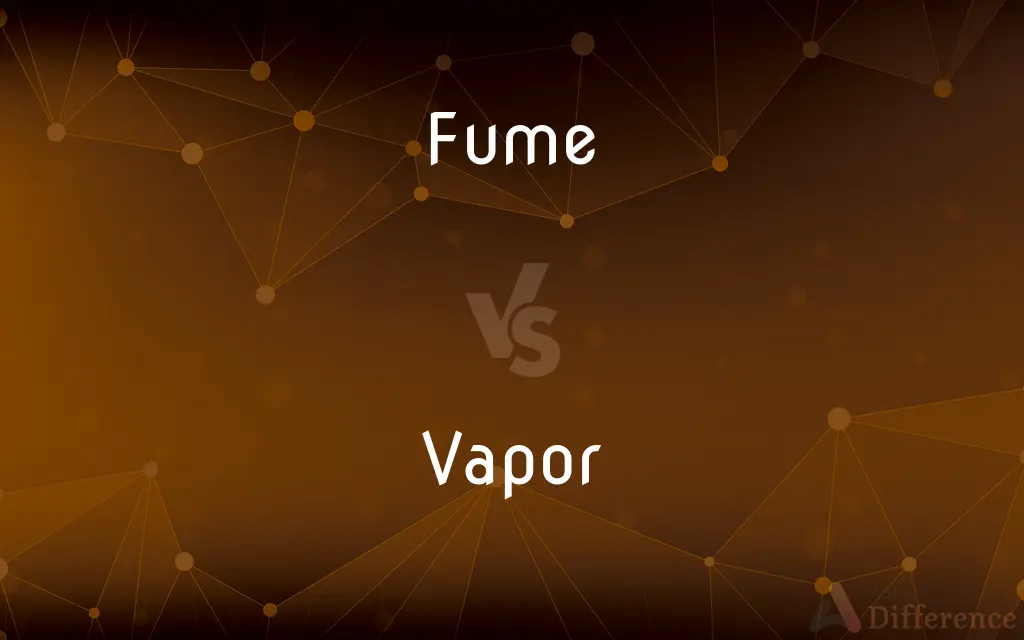Fume vs. Vapor — What's the Difference?
By Fiza Rafique & Maham Liaqat — Updated on March 9, 2024
Fume refers to smoke or gas, especially harmful, produced by combustion or chemical reaction. Vapor is the gaseous state of a substance that is liquid or solid at room temperature.

Difference Between Fume and Vapor
Table of Contents
ADVERTISEMENT
Key Differences
Fumes are often the result of chemical reactions or the combustion of materials, producing fine particles suspended in gas or air. These particles can be harmful if inhaled, making fumes a concern in environments like industrial sites or during welding processes. Vapor, on the other hand, is the gas phase of a substance that, under standard conditions, is not gas. This means when a liquid or solid substance increases in temperature, it turns into a vapor.
While fumes can contain a mixture of different substances, including solid particles, vapors are typically composed of molecules that have evaporated from a liquid or solid state. For instance, the fumes produced in metalworking processes contain metal particles, whereas water vapor consists solely of water in its gaseous state. This distinction is crucial for understanding the potential health impacts and the methods required for mitigation or control.
In terms of health and safety, fumes are often considered more hazardous than vapors because they can contain toxic substances in particle form that can penetrate deep into the lungs. For example, inhaling fumes from chemicals or heavy metals can lead to serious respiratory conditions or other health issues. Vapors, while also potentially harmful if inhaled in large quantities or if the substance is toxic, often pose risks due to their chemical properties rather than particulate matter.
Control measures for fumes and vapors differ due to their physical and chemical properties. Fume extraction systems, for example, are designed to capture and filter out particles from the air, whereas vapor control often involves ventilation or condensation techniques to manage the concentration of the gas in the air. Understanding the nature of the hazard—whether fume or vapor—is essential for implementing effective safety protocols.
Despite these differences, both fumes and vapors can be invisible and pose significant risks to health and safety, making proper identification and control crucial in various environments. The terms are sometimes used interchangeably in casual conversation, but their technical definitions highlight the importance of distinguishing between the two for environmental health and safety practices.
ADVERTISEMENT
Comparison Chart
Composition
Particles suspended in gas, often resulting from combustion or chemical reactions
Gas phase of a substance that is a liquid or solid under standard conditions
Origin
Produced through burning, welding, or chemical reactions
Formed when a substance evaporates or sublimates
Health Risks
Can contain toxic particulates, posing respiratory and other health risks
Risks mainly from chemical properties; can be toxic if the substance is hazardous
Control Measures
Fume extraction systems to filter out particles
Ventilation, condensation to manage gas concentration
Example
Fumes from welding or burning plastics
Water vapor or the vapor of volatile organic compounds
Compare with Definitions
Fume
Tiny particles created by burning.
The factory's smokestacks emitted toxic fumes into the air.
Vapor
Visible mist or gas in natural settings.
Morning dew is formed from water vapor condensing on cool surfaces.
Fume
Particulate matter from melting or welding metals.
Metal fumes from welding can cause serious respiratory problems.
Vapor
Pure substance in gas form at room temperature.
Mercury vapor is used in some types of lighting.
Fume
Smoke containing harmful substances.
The burning of synthetic materials in the fire produced noxious fumes.
Vapor
The gas phase of a substance usually found as a liquid or solid.
Boiling water produces steam, which is water vapor.
Fume
Gases or smoke released from chemical processes.
Mixing certain chemicals in the lab generated dangerous fumes.
Vapor
Substance turned gas from liquid or solid.
The aroma of the food was due to the vapors released during cooking.
Fume
Small, often toxic, particles suspended in air.
Workers are advised to wear masks to avoid inhaling fumes.
Vapor
Gas phase used in refrigeration cycles.
The refrigerator works by compressing and expanding refrigerant vapor.
Fume
An amount of gas or vapour that smells strongly or is dangerous to inhale
Clouds of exhaust fumes spewed by cars
Vapor
In physics, a vapor (American English) or vapour (British English and Canadian English; see spelling differences) is a substance in the gas phase at a temperature lower than its critical temperature, which means that the vapor can be condensed to a liquid by increasing the pressure on it without reducing the temperature. A vapor is different from an aerosol.
Fume
Feel, show, or express great anger
‘We simply cannot have this’, she fumed
The minister reportedly fumed at officials of the department
Vapor
The gaseous state of a substance that is liquid or solid at room temperature.
Fume
Emit gas or vapour
Fragments of lava hit the ground, fuming and sizzling
Vapor
A faintly visible suspension of fine particles of matter in the air, as mist, fumes, or smoke.
Fume
Vapor, gas, or smoke, especially if irritating, harmful, or strong.
Vapor
A mixture of fine droplets of a substance and air, as the fuel mixture of an internal-combustion engine.
Fume
A strong or acrid odor.
Vapor
Something insubstantial, worthless, or fleeting.
Fume
A state of resentment or vexation.
Vapor
A fantastic or foolish idea.
Fume
To subject to or treat with fumes.
Vapor
Exhalations within a bodily organ, especially the stomach, supposed to affect the mental or physical condition. Used with the.
Fume
To give off in or as if in fumes.
Vapor
A nervous disorder such as depression or hysteria. Used with the.
Fume
To emit fumes.
Vapor
To fill or cover with vapor
Perfume vapored the room.
Fume
To rise in fumes.
Vapor
To vaporize
“You wished you'd seen one of the monster shots that vapored an atoll way back when” (Don DeLillo).
Fume
To feel or show resentment or vexation.
Vapor
To give off vapor.
Fume
A gas or vapour/vapor that is strong-smelling or dangerous to inhale.
Don't stand around in there breathing the fumes while the adhesive cures.
Vapor
To evaporate
The fog vapored away.
Fume
A material that has been vaporized from the solid or liquid state to the gas state and re-coalesced to the solid state.
Lead fume is a greyish powder, mainly comprising lead sulfate.
Vapor
To engage in idle, boastful talk
Vapored on about his accomplishments.
Fume
Rage or excitement which deprives the mind of self-control.
Vapor
Cloudy diffused matter such as mist, steam or fumes suspended in the air.
Fume
Anything unsubstantial or airy; idle conceit; vain imagination.
Vapor
The gaseous state of a substance that is normally a solid or liquid.
Fume
The incense of praise; inordinate flattery.
Vapor
Something insubstantial, fleeting, or transitory; unreal fancy; vain imagination; idle talk; boasting.
Fume
(obsolete) A passionate person.
Vapor
(dated) Any medicinal agent designed for administration in the form of inhaled vapour.
Fume
(transitive) To expose (something) to fumes; specifically, to expose wood, etc., to ammonia in order to produce dark tints.
Vapor
Hypochondria; melancholy; the blues; hysteria, or other nervous disorder.
Fume
(transitive) To apply or offer incense to.
Vapor
(obsolete) Wind; flatulence.
Fume
(intransitive) To emit fumes.
Vapor
(intransitive) To become vapor; to be emitted or circulated as vapor.
Fume
(intransitive) To pass off in fumes or vapours.
Vapor
(transitive) To turn into vapor.
To vapor away a heated fluid
Fume
To express or feel great anger.
He’s still fuming about the argument they had yesterday.
Vapor
To emit vapor or fumes.
Fume
To be as in a mist; to be dulled and stupefied.
Vapor
(intransitive) To use insubstantial language; to boast or bluster.
Fume
Exhalation; volatile matter (esp. noxious vapor or smoke) ascending in a dense body; smoke; vapor; reek; as, the fumes of tobacco.
The fumes of new shorn hay.
The fumes of undigested wine.
Vapor
(transitive) To give (someone) the vapors; to depress, to bore.
Fume
Rage or excitement which deprives the mind of self-control; as, the fumes of passion.
Vapor
Any substance in the gaseous, or aëriform, state, the condition of which is ordinarily that of a liquid or solid.
Vapor is any substance in the gaseous condition at the maximum of density consistent with that condition. This is the strict and proper meaning of the word vapor.
Fume
Anything vaporlike, unsubstantial, or airy; idle conceit; vain imagination.
A show of fumes and fancies.
Vapor
In a loose and popular sense, any visible diffused substance floating in the atmosphere and impairing its transparency, as smoke, fog, etc.
The vapour which that fro the earth glood [glided].
Fire and hail; snow and vapors; stormy wind fulfilling his word.
Fume
The incense of praise; inordinate flattery.
To smother him with fumes and eulogies.
Vapor
Wind; flatulence.
Fume
Solid material deposited by condensation of fumes; as, lead fume (a grayish powder chiefly lead sulphate).
Vapor
Something unsubstantial, fleeting, or transitory; unreal fancy; vain imagination; idle talk; boasting.
For what is your life? It is even a vapor, that appeareth for a little time, and then vanisheth away.
Fume
To smoke; to throw off fumes, as in combustion or chemical action; to rise up, as vapor.
Where the golden altar fumed.
Silenus lay,Whose constant cups lay fuming to his brain.
Vapor
An old name for hypochondria, or melancholy; the blues.
Fume
To be as in a mist; to be dulled and stupefied.
Keep his brain fuming.
Vapor
A medicinal agent designed for administration in the form of inhaled vapor.
Fume
To pass off in fumes or vapors.
Their parts are kept from fuming away by their fixity.
Vapor
To pass off in fumes, or as a moist, floating substance, whether visible or invisible, to steam; to be exhaled; to evaporate.
Fume
To be in a rage; to be hot with anger.
He frets, he fumes, he stares, he stamps the ground.
While her mother did fret, and her father did fume.
Vapor
To emit vapor or fumes.
Running waters vapor not so much as standing waters.
Fume
To expose to the action of fumes; to treat with vapors, smoke, etc.; as, to bleach straw by fuming it with sulphur; to fill with fumes, vapors, odors, etc., as a room.
She fumed the temple with an odorous flame.
Vapor
To talk idly; to boast or vaunt; to brag.
Poets used to vapor much after this manner.
We vapor and say, By this time Matthews has beaten them.
Fume
To praise inordinately; to flatter.
They demi-deify and fume him so.
Vapor
To send off in vapor, or as if in vapor; as, to vapor away a heated fluid.
He'd laugh to see one throw his heart away,Another, sighing, vapor forth his soul.
Fume
To throw off in vapor, or as in the form of vapor.
The heat will fume away most of the scent.
How vicious hearts fume frenzy to the brain!
Vapor
A visible suspension in the air of particles of some substance
Fume
A cloud of fine particles suspended in a gas
Vapor
The process of becoming a vapor
Fume
Be mad, angry, or furious
Fume
Emit a cloud of fine particles;
The chimney was fuming
Common Curiosities
Are fumes always visible?
Fumes can be visible or invisible, depending on their composition and the size of the particles.
Is water steam considered a vapor?
Yes, steam is water vapor, which is water in its gaseous state.
Can vapors be harmful to health?
Yes, if the vaporized substance is toxic, its inhalation can pose health risks.
How are vapors managed in laboratories?
Using fume hoods and proper ventilation systems to control exposure to harmful vapors.
What is sublimation in the context of vapor?
Sublimation is the process by which a solid turns directly into gas without passing through the liquid phase, producing vapor.
Can the terms fume and vapor be used interchangeably?
While casually they might be used interchangeably, technically they refer to different substances and should be distinguished for accuracy.
What distinguishes fume from vapor?
Fumes consist of fine particles resulting from combustion or chemical reactions, whereas vapors are the gaseous state of substances that are liquid or solid at room temperature.
How can fumes be controlled in an industrial setting?
Through the use of fume extraction systems that filter out harmful particles from the air.
How do vapors affect indoor air quality?
Vapors from volatile organic compounds (VOCs) can degrade indoor air quality and pose health risks.
What safety equipment is recommended when dealing with fumes?
Respirators or masks are recommended to prevent inhalation of toxic fumes.
What role does temperature play in the formation of vapor?
Temperature increases lead to the evaporation or sublimation of substances, forming vapor.
What are common sources of fumes in the workplace?
Welding, metalworking, and chemical manufacturing processes can produce harmful fumes.
How does the control of fumes and vapors contribute to workplace safety?
It minimizes exposure to harmful substances, thereby protecting workers' health and ensuring compliance with safety regulations.
Can fumes contribute to environmental pollution?
Yes, fumes from industrial processes can contribute to air pollution and pose environmental hazards.
Why is proper ventilation important in areas with vapor risks?
To dilute and remove vapors, reducing the risk of inhalation and potential health effects.
Share Your Discovery

Previous Comparison
Behavior vs. Conduct
Next Comparison
Document vs. InstrumentAuthor Spotlight
Written by
Fiza RafiqueFiza Rafique is a skilled content writer at AskDifference.com, where she meticulously refines and enhances written pieces. Drawing from her vast editorial expertise, Fiza ensures clarity, accuracy, and precision in every article. Passionate about language, she continually seeks to elevate the quality of content for readers worldwide.
Co-written by
Maham Liaqat














































